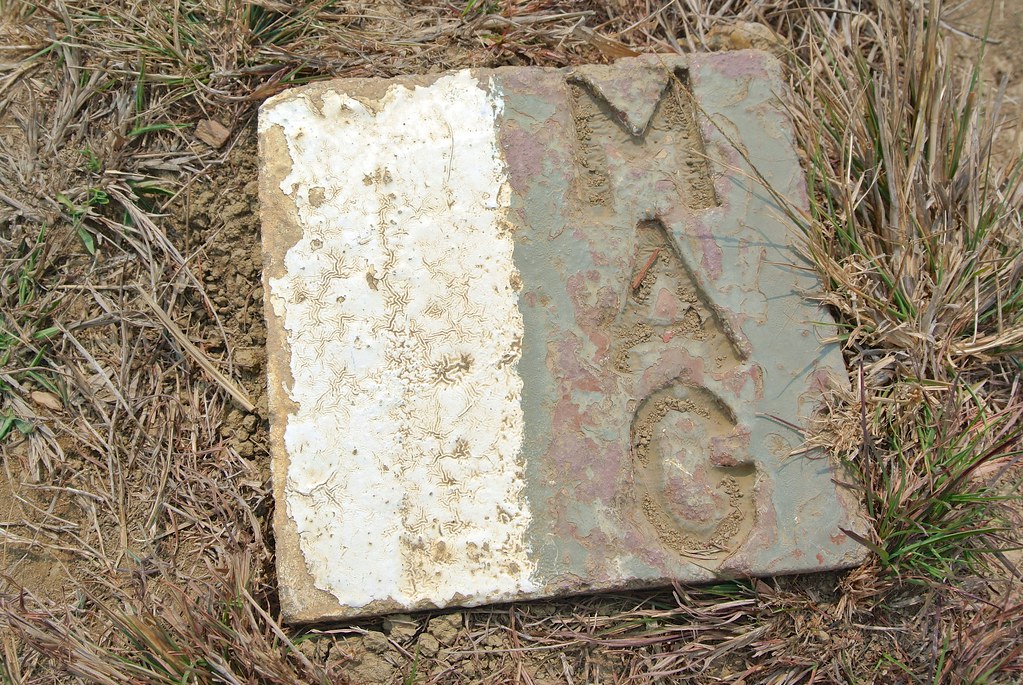After Luang Prabang I took a minibus seven hours to Phonsavan, a small town best known for its Plain of Jars.
Plain of Jars
The Plain of Jars are a collection of sites across a large plain. Each site has a number of ancient stone jars, believed to be used for burial and later on, as urns. Three sites are visited by tourists with a few more open to viewing, but in total there are over 50.
The sites only opened to visitors in 2004 after they were cleared of unexploded ordinance, 127 items of UXO were found and destroyed at site one alone. The sites are only fully clear of UXO on the surface, “sub-surface UXO” takes much longer to clear and has only been done in small areas. As a result, visitors are advised to stay within red and white markers which show where this work has been completed.

Sub-surface UXO has been cleared within the white markers
Everywhere in town arranges tours to the jars but I hired a scooter and went by myself. The downside to this is not having a guide at the sites, but I was able to spend as much time as I wanted there, skip the smallest site and stop at a waterfall on the way back. Site one has the most jars and some of the largest and though site three is much smaller, its location is stunning.

Site one (above). Around site three (below).

UXO
A little background:
During the Vietnam war the North used Laos and Cambodia to transport troops and materials down to the South, the route known as the Ho Chi Minh Trail. In response the American administration and military bombed Laos despite having no approval from congress or declaring war on the country. In fact, congress and the American people didn’t know about it until years later.
In nine years America dropped over two million tons of munitions on Laos - more than they dropped on Germany and Japan combined in WW2 - making it the world’s most heavily bombed nation. While the years of bombing were bad enough, an estimated 30% of the munitions, mostly cluster bombs, failed to detonate when they were dropped. As a result there isn’t a single province in Laos that doesn’t suffer from UXO (unexploded ordinance) and more than 50,000 people were killed or injured from 1964 to 2008 (statistics from MAG). Even today there are around 300 UXO incidents a year, mostly farmers (while digging) and children (the cluster bomb submunitions often look like a tennis ball).

A cluster bomb containing hundreds of bomblets, or “bombies”
History lesson over, there are two charities based in Phonsovan - the second most heavily-bombed region - that are dealing with the aftermath of the American bombing.
The Mines Advisory Group is one of a few charities working in Laos to clear UXO. They don’t just look on the size of the area cleared but how useful the clearing will be; a small patch of land that villagers can use to plant a second rice crop is more important than clearing a large area of unused land. The visitors centre gives information on the clearing work being done and shows movies each evening (one of these is on YouTube). All of the clearing work is done by MAG-trained teams of Lao workers, providing work for locals. A large number of these are women, helping to promote their status in local communities.
Another charity with a visitors centre is QLA, the Quality of Life Association, who have helped victims and families of UXO incidents since 2011. Two of the five founding members are themselves victims of UXO. They offer moral support, cover the cost of prosthetics and regular medical checkups and offer retraining in a new line of work. In one case after a farmer was injured, QLA sent his wife on an Animal Raising course and after finishing, was given a grant to raise pigs.

From the gallery at QLA - A child’s painting of the American bombing
Some of the information at MAG and QLA isn’t pleasant or nice to read about but it’s an important part of Laos’s history and future - the clearing could take hundreds of years at its current pace. The Plain of Jars were interesting but it’s worth going to Phonsavan just to see the work the charities are doing to help peoples lives.
More photos on Flickr.